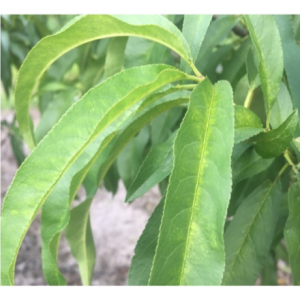
Chlorotic stippling around the mid-vein caused by two-spotted spider mite.
By Breanna Kendrick
Cory Penca, a speaker at the recent Stone Fruit Field Day, covered lots of pests that are potentially devastating to peach growers. Penca is an entomology Ph.D. candidate and a student in the Doctor of Plant Medicine Program at the University of Florida. The last pest he discussed at the event was the two-spotted spider mite.
Mites are related to spiders, but are very small and often require a magnifying glass for identification. Mites cause a bronzing-type damage. A lot of this damage can lead to defoliation, which can be a problem because when leaves are lost, limbs are exposed to the sun. Peaches are susceptible to sunburn injury, which could lead to limb death and other problems. Penca said growers should monitor this pest to make sure they’re not going to get excessive defoliation. Peaches can tolerate moderate infestations, but it’s at higher levels of infestation when defoliation occurs and becomes a problem, he said.
Mites tend to flare up when it’s warm and dry. “Around April and May, you can have temperatures that are in the 90s and lower rainfalls. And so at this period, mites are likely to become a problem,” said Penca. “This coincides with the harvest period as well. When you have people out picking, they might see a lot of mites. They might even have irritation from the spider mites. If you look at the leaves of an infested tree, you might see on the other side some stippling chlorosis towards the midvein. On the top of the leaf, you will see the same. Eventually you can start to see defoliation.”
The Southeastern Spray Guide makes a few different recommendations for controlling this mite problem. “Acramite is one of the most commonly used. It has a three-day pre-harvest interval (PHI). So if you’re making applications around the time of harvest when it’s hot and dry, you have to make sure you’re using this pesticide legally within the PHI window,” stated Penca. “There are two concerns for this miticide for mites. One is it might cause inking on the fruit. It’s also reported that this chemistry is unstable at high pHs, and Florida water can have a high pH level because of our limestone aquifer. So you may need to use an additive to buffer the solution.”
Mites are not a huge problem all the time in Florida, but they can be if it stays dry and warm for a while and gives the mites long enough to survive. According to Penca, the reason mites start to decline when it’s wet is because the high humidity lowers reproduction and there’s more fungi in the area that can actually kill the mites because they’re so small.
Share this Post









